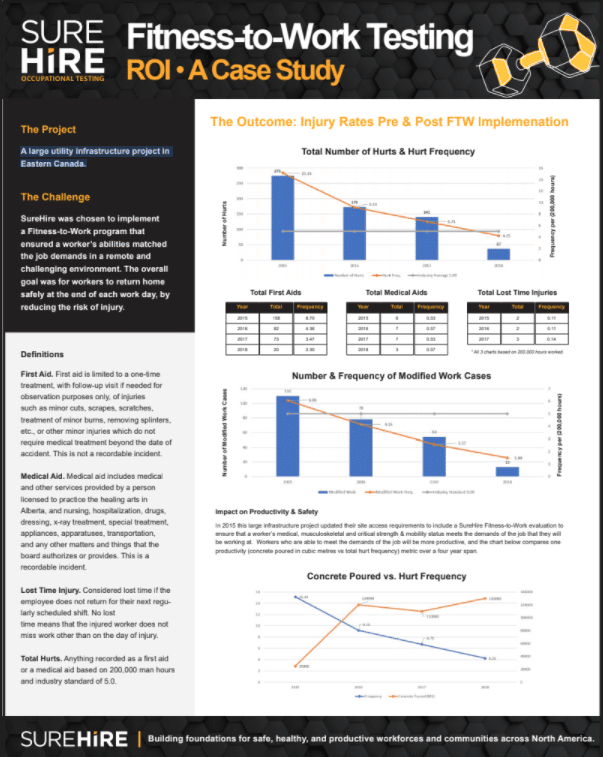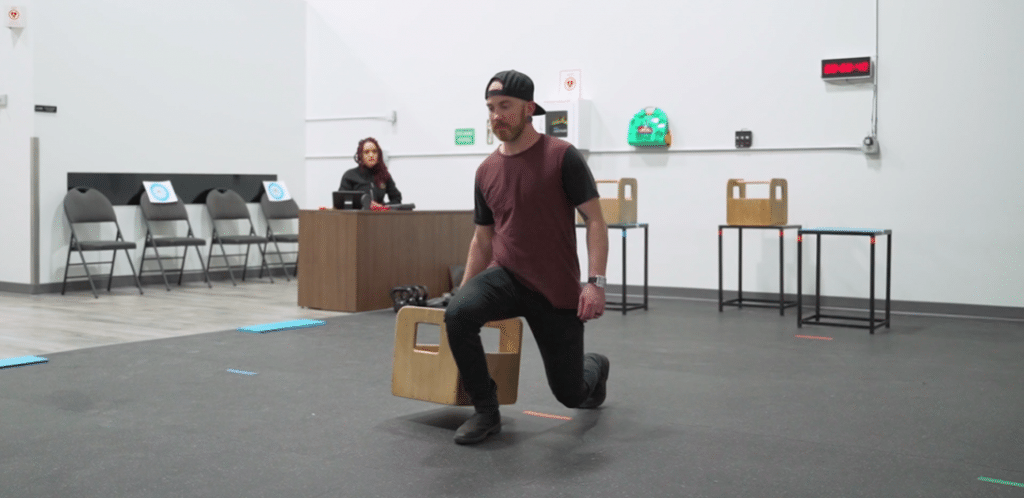TAKEAWAY: A Physical Demands Analysis, or PDA is a detailed breakdown of all job tasks performed by a worker in a specific job position. It evaluates the position, not the worker. PDAs are commonly used to determine the compatibility between a worker and a position as well as determine appropriately modified duties in a return-to-work plan.
Table of contents
A physical demands analysis (PDA) should be considered an essential job foundation. It is a breakdown of all job tasks performed by a worker in a specific job position. A PDA evaluates the role rather than the worker and provides an objective way for employers to identify the necessary tasks for a particular job.
This article explores the parts of a PDA, how to use them, and the top benefits of using PDAs.
Fitness-to-Work Testing FAQs
SureHire’s Fitness-to-work (FTW) evaluations help employers understand an individual’s overall health status and provide recommendations for work accommodations and/or restrictions when necessary. Should an incident occur, employers can also use the information provided through our FTW when applying for cost relief through their province’s worker’s compensation board.
Check out this frequently asked questions video and contact us today to request a quote.
How do Employers use PDAs, and who should complete them?
Employers use PDAs to determine the compatibility between a worker and a position. PDAs also assist the employer in developing modified duties in a return-to-work plan.
PDAs are a prerequisite to fitness-to-work (FTW) testing at SureHire. After a PDA is complete, a reviewer recommends a standard or custom FTW test to best fit the PDA.
The worker and a trained employee representative could complete a PDA. Or it could be completed by a qualified physical health practitioner with training in PDAs. Companies can use trusted occupational testing experts like SureHire to ensure the process runs smoothly from analysis to the next steps.
A SureHire PDA covers areas such as:
- Frequency of manual handling tasks
- Frequency of positional tasks, including bending forward, sitting or driving, trunk rotation, and standing
- Primary job duties and the required strength level for each task
- The heaviest and most frequently handled materials, tools, and equipment
- Alternate job duties
What are BFORs?
A Bona Fide Occupational Requirement (BFOR) is a necessary job performance criterion. While employers cannot discriminate based on minor inconveniences or preferences, a BFOR is a reasonable standard. An employer must not be able to accommodate an employee without undue hardship, and BFORs must not violate civil rights employment laws.
Examples of BFORs include:
- A men’s clothing manufacturer can legally advertise for male models
- Lawful enforcement of mandatory retirement ages for bus drivers and airline pilots due to safety concerns
- Minimum weight lifting requirements for firefighters to demonstrate they can safely carry fire victims out of a building
SureHire uses a company’s BFORs in conjunction with a PDA for a specific job role. Then we evaluate role-specific physical capabilities before we provide detailed hiring recommendations.

Fitness-For-Duty Testing: A Case Study
When it comes to the overall wellbeing of your workforce, the onus is on you, the employer, to ensure safe operation and risk mitigation. SureHire helps employers mitigate risk by offering comprehensive fitness-to-work / fit-for-duty testing aimed to evaluate an individual’s physical capabilities as they pertain to a specific role. Check out this case study and see the injury rates pre and post-fitness-to-work program implementation.
Have questions? Looking for a quote?
6 reasons employers should be using a physical demands analysis
There are several benefits and practical applications for PDAs. The following are six top reasons employers should use them.
1. A benchmark for physical requirements
PDAs allow employers to understand physical job requirements clearly. This knowledge can enable them to make informed work requirement decisions and reduce the chance of employee injury.
2. Detailed job insights for employer decision making
PDAs provide detailed job insights that enable employers to make decisions and take appropriate actions. A PDA is essentially a job position analysis that identifies risk factors. It ensures the employer can determine whether modifications to the workplace environment or job tasks are necessary.
For example, a PDA for an office worker could identify risks such as lower back strain from long sitting periods and eye strain from extended computer use. With these insights, the employer can take action to reduce such risks.
They may decide to create an ergonomically-friendly workstation set-up with sit-stand work desks, ergonomic chairs and keyboards, and optimal lighting. Additionally, they can adopt workplace wellness initiatives that serve as education and training for optimal physical health.
Another PDA could indicate a high frequency of manual handling tasks. This knowledge prompts the employer to provide accommodations such as mechanical assistance where needed. Additionally, they could develop a job rotation policy and introduce more varied job tasks.
In conjunction with FTW testing, the employer can use the PDA to ensure the person is the right fit for the role.
3. A basis for employee education and training
Employers can also educate employers about reducing the risk of injury with their PDA insights. They can provide education and training opportunities to help employees look after their physical health. When an employer understands an employee’s job task requirements, they could offer education in specific areas to help them meet the physical demands.
Examples include:
- The importance of taking regular work breaks to rejuvenate the mind and body.
- Optimal nutrition and hydration to meet the required energy demands of the job.
- Stress management because excessive stress places additional demands on the body beyond the job tasks.
- Education and training on specific fitness components, such as strength, cardiovascular fitness, and mobility.
- Education and training on lifting techniques, especially those relevant to job tasks.
4. Useful in different stages of employment
PDAs are helpful in different stages of employment. They can form part of an onboarding process to orient new employees by confirming that a worker has the required physical capabilities. A PDA helps with hiring decisions at the outset. They enable employers to feel confident about placing an employee in an appropriate job position where they are not likely to overstrain their body or sustain a job-related injury.
Employers can also utilize PDAs as part of a return-to-work plan after an injury. Doing so ensures the employee’s job role is suitable while recovering. Based on PDA insights, the employer may place the employee in a modified or different job role during the recovery period. For example, they might assign a manual equipment handler administrative tasks while recovering from a sprained ankle.
5. A physical demands analysis is entirely customized
Companies need customizable solutions in all areas of business. Every industry, job role, and employee is unique. Employers who use PDAs recognize this and understand that PDAs reflect their specific business needs. They can then create custom solutions such as rehabilitation programs for specific job roles.
6. Improves the company’s bottom line
Finally, using PDAs helps to improve the company’s bottom line. By understanding the physical requirements of a role and ensuring the person is the right fit for the job, there is less risk of an employee becoming injured.
Injuries carry immense associated business costs related to missed workdays, medical expenses, and decreased productivity. Any business that cares about its staff’s wellbeing and wants to minimize the chance of injury-related costs will understand the value of using PDAs.
If an employee does become injured, PDAs can reduce return-to-work time following the injury. Essentially, there is a clear understanding of job task requirements, role modifications, and accommodations in a return-to-work plan.
Contact SureHire to navigate your workplace PDA requirements.

SureHire’s Fitness-to-Work Testing
SureHire uses the information in a PDA to determine the appropriate level of Fitness-to-Work (FTW) testing (also known as fit-for-duty testing).
The PDA is first reviewed by a SureHire FTW Reviewer before they produce a recommendation of standard FTW level of testing or Custom FTW test (whichever best fits the submitted PDA.)
Have questions?
You May Also Be Interested In…
- Do You Have Reasonable Suspicion?
 Employers cannot initiate reasonable suspicion testing without first going through the 5-step process. Reasonable suspicion training provides critical information about how to initiate reasonable suspicion testing, including the 5-step process and other tools that employers can use to help manage the misuse of alcohol and drugs in the workplace.
Employers cannot initiate reasonable suspicion testing without first going through the 5-step process. Reasonable suspicion training provides critical information about how to initiate reasonable suspicion testing, including the 5-step process and other tools that employers can use to help manage the misuse of alcohol and drugs in the workplace. - An Employer’s Guide: What You and Your Employees Need to Know About DOT Drug & Alcohol Testing
 When implementing or maintaining DOT Drug & Alcohol testing, there are key areas that employers should consider.
When implementing or maintaining DOT Drug & Alcohol testing, there are key areas that employers should consider. - SureHire Occupational Testing Acquires COHR Health: A Positive Step Towards Safe, Healthy, Productive Workforces and Communities
 We are thrilled to announce that today, May 6, 2024, SureHire Occupational Testing has officially acquired COHR Health, a well-known leader in occupational health services. Read on…
We are thrilled to announce that today, May 6, 2024, SureHire Occupational Testing has officially acquired COHR Health, a well-known leader in occupational health services. Read on… - Occupational Testing Use Case – Mining
 In this case study, we will explore how mining companies can use various types of occupational tests to reduce Total Recordable Incident Rates (TRIR) long term.
In this case study, we will explore how mining companies can use various types of occupational tests to reduce Total Recordable Incident Rates (TRIR) long term. - 9 Strategies to Keep Workers Cool on Drilling Sites During Hot Summer Months
 This article delves into strategies to keep workers cool and safe on drilling sites during the hot summer months.
This article delves into strategies to keep workers cool and safe on drilling sites during the hot summer months. - Hearing Conservation Basics: How to Manage Occupational Noise
 Learn how to proactively mitigate occupational noise risks and help prevent NIHL among workers.
Learn how to proactively mitigate occupational noise risks and help prevent NIHL among workers.

